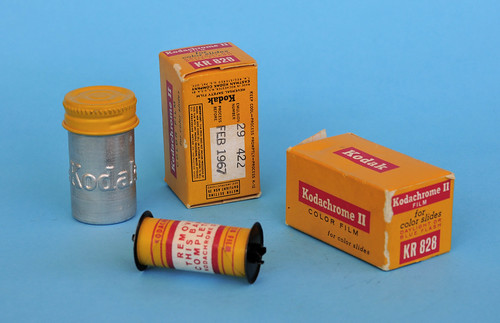Difference between revisions of "828 film"
m (Added text) |
(Added a little text.) |
||
| Line 9: | Line 9: | ||
'''828''' film was [[Kodak]]'s unperforated 35mm paper-backed [[rollfilm|roll film]], introduced in 1935. The image size of [[35mm|standard 35mm film]] was considered "miniature" in the 1930s; but by eliminating the sprocket holes (a vestige of 35mm film's movie origins) Kodak could increase 828's image area by 30% (to 28x40mm). A smaller diameter spool allowed for smaller camera designs as well. [[Kodak Bantam | Kodak's Bantam]] camera series used 828 film, and so the size is often known by the "Bantam" name. | '''828''' film was [[Kodak]]'s unperforated 35mm paper-backed [[rollfilm|roll film]], introduced in 1935. The image size of [[35mm|standard 35mm film]] was considered "miniature" in the 1930s; but by eliminating the sprocket holes (a vestige of 35mm film's movie origins) Kodak could increase 828's image area by 30% (to 28x40mm). A smaller diameter spool allowed for smaller camera designs as well. [[Kodak Bantam | Kodak's Bantam]] camera series used 828 film, and so the size is often known by the "Bantam" name. | ||
| − | Kodak also made | + | Kodak also made adapters for using 828 film in three of their 620 cameras: the [[Kodak Chevron|Chevron]], [[Tourist]] and [[Kodak Reflex|Reflex]]. |
| + | Zeiss Ikon made an 828 adapter for the [[Super Ikonta]] B and BX cameras called the "Color Adapter". | ||
Other paper-backed 35mm film formats have included [[Bolta film|Bolta]] and the film [[Konica|Konishiroku]] produced for the [[Konilette]]. | Other paper-backed 35mm film formats have included [[Bolta film|Bolta]] and the film [[Konica|Konishiroku]] produced for the [[Konilette]]. | ||
Revision as of 05:21, 23 September 2015

|
| 828 Kodachrome II packaging image by Dirk HR Spennemann (Image rights) |
828 film was Kodak's unperforated 35mm paper-backed roll film, introduced in 1935. The image size of standard 35mm film was considered "miniature" in the 1930s; but by eliminating the sprocket holes (a vestige of 35mm film's movie origins) Kodak could increase 828's image area by 30% (to 28x40mm). A smaller diameter spool allowed for smaller camera designs as well. Kodak's Bantam camera series used 828 film, and so the size is often known by the "Bantam" name.
Kodak also made adapters for using 828 film in three of their 620 cameras: the Chevron, Tourist and Reflex. Zeiss Ikon made an 828 adapter for the Super Ikonta B and BX cameras called the "Color Adapter".
Other paper-backed 35mm film formats have included Bolta and the film Konishiroku produced for the Konilette.

|
| 828 film marked "For Kodak Bantam Cameras" image by Geoff Harrisson (Image rights) |
Links
- Kodak Bantam Special including a history of 828, by Brian Wallen
- Kodak 828 Film replacement options by Brian Wallen
- "Feeding a classic" (a thread at Nelsonfoto forums), about using cut-down 120 film

|
| 828 film spool compared to modern 35mm cassette image by AWCam (Image rights) |